Lieutenant
“A Brilliant Flying Spirit”
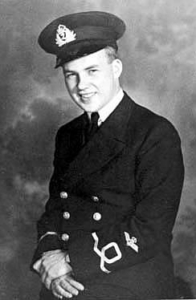
Newly commissioned Sub-Lieutenant Hampton Gray following his graduation as a pilot at Kingston in September 1941. Photo courtesy of Mrs. Phyllis Gautschi’s private collection.
His early life was unremarkable – a quiet family upbringing in a pretty BC town, happy school days, and aspirations to become a doctor. But war changed everything for Hampton Gray; under the surface of his thoughtful character was revealed the bedrock of courage.
Robert Hampton Gray was born November 2, 1917, in Trail, BC, to John Balfour Gray and his wife, Wilhelmina. The Grays and their three children later moved to Nelson, BC.
Hampton, nicknamed Hammy, was a fun-loving student who made friends easily and had a strong interest in sports.
He graduated from high school in 1936 and enrolled at the University of Alberta, then transferred to the University of BC in 1939, intending to go on to McGill University for medical training.
At UBC, he was very involved with fraternity and campus social activities. He was also Associate Editor of the campus yearbook, the Totem, where he worked with Pierre Berton, who was then on the editorial staff. Berton recalls Gray as being quiet and thoughtful, in contrast to his more active social image in university circles.
Hammy Gray, like other members of the student peace movement, considered the war in Europe remote and no threat to Canada.
This view was rapidly dispelled when German armoured divisions blasted through the Allied front in the spring of 1940.
In summer 1940, Gray decided to enlist. He and two long-time friends went to HMCS Tecumseh and applied to join the Royal Canadian Naval Volunteer Reserve (RCNVR) as officer candidates to serve on loan with the Royal Navy. When they arrived in England, he and the rest of the Canadian candidates soon realized the road to officer status wouldn’t be swift. So when an opportunity to switch to the Royal Navy Fleet Air Arm as a pilot materialized, Gray accepted, although he had never previously expressed interest in flying.
The Royal Navy Fleet Air Arm was expanding rapidly. There was tremendous need for aircrew, and Gray quickly progressed through pilot training. By September 1941, he was a naval pilot with the rank of Sub. Lieutenant. Following further training, Gray was sent to the African theatre of operations. He flew Hurricanes and other aircraft for various Royal Navy shore-based squadrons, and spent nearly two years in Africa. Now a lieutenant with valuable flying experience, Gray became concerned the war was passing him by. He badly wanted to fly in an operational carrier-based fighter squadron.
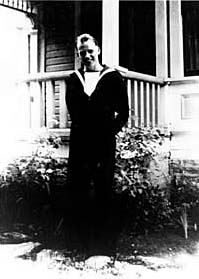
Hampton Gray in his naval uniform, pictured outside the family home in Nelson, BC. Photo courtesy of John Kenross.
His wishes were granted in August 1944. Following a flying conversion to the Vought Corsair U.S.-built fighter, Gray was appointed on 14 August 1944 to 1841 Squadron aboard HMS Formidable as Senior Pilot. To read a complete version of the Squadron’s dairy for the period from 1 March 1944 to mid-August 1945, see the sidebar on the right of this page (“1841 Squadron Diary“).
Just two months earlier the Corsair squadron had lost its first two senior pilots during strikes against the German battleship. The first pilot was shot down and the other crash-landed in Norway; both were now prisoners of war. After four years’ service, Hammy Gray was going into combat.
In August 1944, he saw action involving four attacks against Tirpitz when the 42,500-ton vessel was holed up in a Norwegian fjord. In the fourth attack, on August 18, Gray led his flight in a daring low-level strike against ships protecting the battleship. Other targets included the adjacent seaplane base and airfields, in a bid to draw fire away from the attacking Barracuda dive-bombers. The bombing attacks failed. Six Corsairs were lost and three Barracudas crashed on landing.
The final strike came on August 29, when Gray repeated his audacious low-level attack against three heavily armoured German Narvik class destroyers. His aircraft, and 16 other Corsairs, suffered flak damage. An additional Corsair was lost. Hammy Gray was awarded a Mention in Dispatches for his “undaunted courage, skill and determination in carrying out daring attacks on the … Tirpitz.” Gray was in the thick of the action at last, his combat leadership skills now well established.
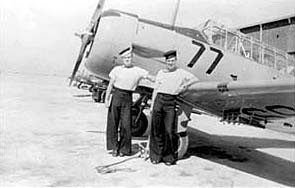
Hampton Gray (right) and Hal Tibbets pictured at Kingston Services Flying School, summer 1941. The aircraft is a single-engined Harvard.
HMS Formidable’s next assignment was the Pacific. The carrier joined the British Pacific Fleet in April 1945. The first major action was strikes against Japanese air bases supporting Japan’s defence of Okinawa. Aircrew losses were heavy – the British carriers lost 47 aircraft to enemy fire and operational causes.
Gray’s character during this period is reflected in a letter home to his parents. To ease their fears, he played down the air operations as “fairly hard flying, but not dangerous.” Similarly, he downplayed the effect of the deadly Kamikaze attacks on his ship, and the dreadful loss of personnel and aircraft.
Gray’s ability to lead under such heavy pressure while remaining relaxed was remarkable. Captain Ruck-Keen, Formidable’s Commanding Officer, made special note of his unruffled manner while under combat stress.
By July 1945, the combined Allied fleets were attacking the Japanese mainland, striking any target to be found. Gray continued to lead his flights in heavy strikes. In addition to successful low-level strafing attacks against airfields, he headed a strike against the Japanese naval base at Maisuru. Here he made a direct hit on a Japanese destroyer, setting it afire and finally sending it to the bottom of the ocean. His leadership in this action against well-defended ships was so remarkable that Admiral Vian, then in command of the Carrier Group, sent a congratulatory message to Formidable. The message praised Gray’s “resolute and professional manner” and recommended him for the immediate award of the Distinguished Service Cross.
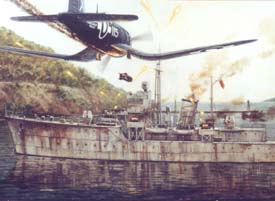
Hampton Gray’s final moments are brought to vivid life in the paintings of aviation artist Don Connolly.
By August 1945, after the atomic bombing of Hiroshima, it became clear the war was nearly over. Captain Ruck-Keene had already spoken to his squadron commanders and cautioned them to pass the word along that all pilots were to avoid taking unnecessary risks. They were to minimize flight hazards by making only one attack run on each target. All pilots were specifically briefed on this procedure.
On August 9, 1945, as the second atomic bomb fell on Nagasaki, the air war against Japan targets continued unabated. For the second launch of his day, Hammy Gray led two flights of Corsairs against airfields in the Matsushima area, northern Honshu. There was little enemy activity; a first strike from Formidable had left the targets in ruins. Since Gray was briefed for the secondary target of naval ships at nearby Onagawa Bay, he decided to attack.
The other flight members recall him saying he was going in, and peeled off to follow him in the high speed run. As Gray levelled out his Corsair, it was blasted with cannon and machine gun fire. The aircraft was set on fire, and one of his 500 lb. bombs was shot off. He then steadied the aircraft, and aimed his remaining bomb. This bomb hit the ocean escort vessel Amakusa below the after gun turret, exploded the ammunition locker, and blew out the starboard side of the ship. Amakuza rolled and sank immediately.
Gray continued flying but brief seconds later his burning aircraft rolled over, hit the water at high speed, and broke up. Gray was killed, becoming one of the last Canadians to die in combat in WW2. Despite the shock of losing their leader, and in spite of the order to make only one run at each target, the remaining pilots conducted two more successful attacks on the target Japanese ships.
In a letter of condolence to Mrs. Gray, 1841’s Commanding Officer, LCdr (A) Richard Bigg-Wither, expressed the strong sense of loss and grief he and his colleagues experienced over Gray’s death. (To read the full text of his letter see ‘Condolence Letter to Mrs. Gray‘)
The bottom fell out of life on board after it happened and the victory, when it came, seemed so hollow somehow. He was so well loved by us all and simply radiated happiness wherever he went.
Hammy Gray was awarded the Distinguished Service Cross on August 31, 1945 for “determination and address in air attacks on targets in Japan on the 18th, 24th and 28th of July 1945.”
On November 13, 1945 Hammy Gray was posthumously awarded the British Commonwealth’s highest medal for valour, the Victoria Cross. In part, his citation read: “Lieutenant Gray has consistently shown a brilliant flying spirit and most inspiring leadership.”

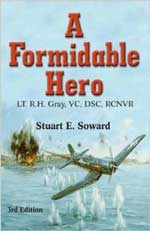
 CFB Esquimalt Naval and Military Museum
CFB Esquimalt Naval and Military Museum CFB Esquimalt Naval and Military Museum
CFB Esquimalt Naval and Military Museum
 CFB Esquimalt Naval and Military Museum
CFB Esquimalt Naval and Military Museum CFB Esquimalt Naval and Military Museum
CFB Esquimalt Naval and Military Museum CFB Esquimalt Naval and Military Museum
CFB Esquimalt Naval and Military Museum CFB Esquimalt Naval and Military Museum
CFB Esquimalt Naval and Military Museum CFB Esquimalt Naval and Military Museum
CFB Esquimalt Naval and Military Museum CFB Esquimalt Naval and Military Museum
CFB Esquimalt Naval and Military Museum
